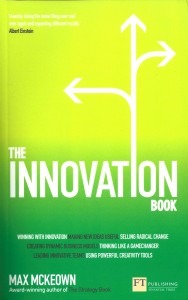The one-sentence summary
It is possible to become a competent innovator by being aware of powerful techniques and approaches that have succeeded elsewhere.
WHAT THE BOOK SAYS 
- This is effectively a workbook that explains how to manage ideas and execution for outstanding results. It provides a comprehensive overview of the entire genre of innovation.
- An innovator’s approach involves collecting ideas, transforming them into something else, exploring them in detail, and nurturing them through to execution.
- You need a healthy dissatisfaction to achieve this – an unwillingness to accept traditional limitations, a restless desire for novel experiences, and a frustration with things as they currently are.
- It takes a fair amount of pain to make progress. Unnecessary pain is caused by avoidable mistakes and uncaring application of new ideas. Industry pain involves existing structures that hold things up. People pain is where individuals struggle to make progress. Necessary pain is the total effort to develop and make room for the new (and better) idea.
- Quitting can be winning. Knowing when to give up and try something else can save a lot of wasted effort.
WHAT’S GOOD ABOUT IT
- Adaptability is vital to your approach. Compare the attitude needed:
High adaptability > > > > > > > Low adaptability
Take risks to make gains Take risks to avoid losses
Uncertainty starts new learning Certainty from old learning
Explore to increase options Exploit to increase profits
Driven by future opportunities Driven by conformity
Learn by experimentation ‘Learn’ from tradition
- Companies need to make sure they are not idea-toxic (creativity unwelcomed) or idea-wasteful (new ideas treated casually and mismanaged).
- FFE is the Fuzzy front End. A lot is unclear during innovation and executives need to get comfortable with an element of this uncertainty as a permanent way of life.
- Functional fixedness stops people and companies from solving problems creatively because they have fixed assumptions. Children don’t, for example.
- The wave analogy sums up 4 approaches to innovation: stranded (left behind it); surfing (taking full advantage); shaping (inventing the next thing); smashed (standing against it and failing to adapt).
- Beware of novelty overload. New ideas fight for attention, time and resources, and can prove very distracting if not properly channelled.
- The author has to conform to a series format that is mildly constricting but effectively bypassed by the excellent toolkit of innovation techniques at the end – a must-read section for anyone needing a primer in the subject.
WHAT YOU HAVE TO WATCH
- The author has to conform to a series format that is mildly constricting but effectively bypassed by the excellent toolkit of innovation techniques at the end – a must-read section for anyone needing a primer in the subject.
